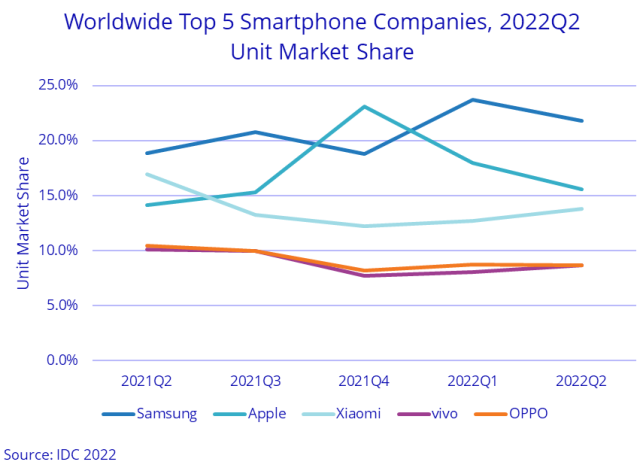Xiaomi, Vivo and OPPO have lost significant market share in the global smartphone business during the second quarter of 2022, according to reports from IDC and Canalys.
 Xiaomi’s smartphone share fell to 13.8 percent in Q2 2022 vs 16.9 percent in Q2 2021. Xiaomi shipped 39.5 million smartphones during the second quarter.
Xiaomi’s smartphone share fell to 13.8 percent in Q2 2022 vs 16.9 percent in Q2 2021. Xiaomi shipped 39.5 million smartphones during the second quarter.
Vivo’s smartphone share dropped to 8.7 percent in Q2 2022 vs 10.1 percent in Q2 2021. Vivo shipped 24.8 million smartphones during the second quarter.
OPPO’s smartphone share decreased to 8.6 percent in Q2 2022 vs 10.5 percent in Q2 2021. OPPO shipped 24.7 million smartphones during the second quarter.
Both Samsung and Apple gained share in the global smartphone market. Samsung’s share increased to 21.8 percent from 18.9 percent. Samsung shipped 62.4 million smartphones.
Samsung is pushing aggressive pricing strategies and heavy promotions for its low-end A series, leveraging the cost-effective ODM production to stimulate consumer demand in the mass market. In the premium segment, Samsung stressed its focus on foldable phones and the S series as profit drivers in developed markets, Canalys Research said.
Apple achieved 15.6 percent share as compared 14.2 percent. Apple shipped 44.6 million iPhones during the second quarter.
Canalys Research Analyst Runar Bjorhovde said: “Solid demand for the iPhone 13 series in North America, China and Europe enabled Apple to grow despite the headwinds. The high end has proven relatively resilient during the recession, while promotions and financing options have helped with affordability.”
Major Chinese vendors managed to stabilize their worldwide performance compared with last quarter despite another round of double-digit year-on-year contractions.
“We have seen the top Chinese players focus on very different strategic priorities during the downturn. Xiaomi is ambitious to expand its high-end portfolio in China through its latest partnership with Leica, with new products hitting the market in Q3. It has also been adjusting product upgrade cycles to speed up launches in the mass market, leveraging its supply chain capabilities,” said Toby Zhu, Canalys Analyst.





